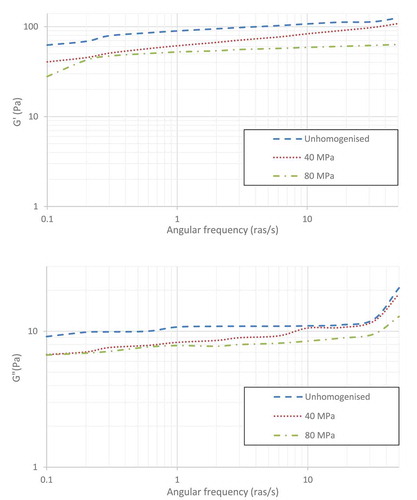 ?Mathematical formulae have been encoded as MathML and are displayed in this HTML version using MathJax in order to improve their display. Uncheck the box to turn MathJax off. This feature requires Javascript. Click on a formula to zoom.
?Mathematical formulae have been encoded as MathML and are displayed in this HTML version using MathJax in order to improve their display. Uncheck the box to turn MathJax off. This feature requires Javascript. Click on a formula to zoom.ABSTRACT
Gelatinized starch paste was prepared by gelatinizing rice starch at 95 °C in a water bath. Then, the rice starch (both normal rice starch and waxy rice starch) paste was subjected to high-pressure homogenization at homogenizing pressure of 20, 40, 60, 80 MPa. The rheological properties (including shear stress versus shear rate, apparent viscosity versus shear rate and thixotropy) of starch paste were studied. The high-pressure homogenization was able to improve the flow properties of starch paste. The shear stress increased with the increasing shear rate, and the Power law equation was capable of fitting the shear stress versus shear rate quite precisely. High-pressure homogenization treatment sharply decreased the thixotropy of starch paste, and the thixotropy of rice starch (both NRS and WRS) paste decreased with the increasing homogenous pressure.
RESUMEN
Para el presente estudio se preparó pasta de almidón gelatinizada, gelatinizando almidón de arroz a 95ºC en un baño de agua. Luego, la pasta de almidón de arroz (tanto de almidón de arroz normal (NRS) como de almidón de arroz ceroso (WRS)) fue sometida a homogeneización a alta presión, utilizando una presión de homogeneización de 20, 40, 60, 80 MPa. Posteriormente, se estudiaron sus propiedades reológicas (incluida la tensión de corte versus la velocidad de corte, la viscosidad aparente versus la velocidad de corte y la tixotropía). La homogeneización a alta presión mejoró las propiedades de flujo de la pasta de almidón. El esfuerzo cortante aumentó con el incremento de la velocidad de corte, y la ecuación de la ley de potencia fue capaz de ajustar la tensión de corte versus la velocidad de corte con bastante precisión. El tratamiento con homogeneización a alta presión disminuyó drásticamente la tixotropía de la pasta de almidón; además, la tixotropía de la pasta de almidón de arroz (tanto NRS como WRS) disminuyó con el aumento de la presión homogénea.
1. Introduction
Starch is one of the most abundant biomass resources in nature, and it is also one of the most widely used polysaccharide polymers made by polymerization of glucose (Fu, Wang, Li, Wei, & Adhikari, Citation2011; Šárka & Dvořáček, Citation2017). Normal starch consists of 15-35% amylose and 65-85% amylopectin, while waxy starch is almost composed of amylopectin. As a renewable biomass resource, starch is widely used in food (as a thickener or gels), textile (for textile warp sizing), papermaking (as a sizing agent) and pharmaceutical industry (as antibacterial agent) (Li & Lim, Citation2016; Poonguzhali, Khaleel Basha, & Sugantha Kumari, Citation2018; Turcanu et al., Citation2018; Zhou, Gao, Kong, & Zhu, Citation2018). Retrograded starch can be used as low calorific value food for obese people or diabetic patients (Dong-soon, Zihua, Jay-lin & Huang Jihong, Citation2005). Waxy starch has a higher degree of expansion, higher transparency, higher viscosity and greater stability than normal starch. Therefore, waxy starch can be used as high-quality raw materials for producing modified starch, brewing beer, ice cream, and oyster sauce (Byars, Citation2002; Deng & Xu, Citation2014; Homayouni, Azizi, Ehsani, Yarmand, & Razavi, Citation2008; Vernon-Carter et al., Citation2018; Wang, Feng, & Wen, Citation2005).
With the development of industry, there is an increasing interest to prepare modified starch year by year as the modified starch is playing the more and more vital role in the starch industry. Modified starch can be obtained by using physical, chemical, and enzymatic methods from nature starch (Bet et al., Citation2018; Colussi et al., Citation2014; Guo, Citation2018). The molecular cutting or rearrangement, oxidation, and the introduction of substituents may be taken place in starch molecules, which result in enhancements in some properties. The modified starch gets over the defects of aging, syneresis, and poor stability. Meanwhile, the modified starch can meet the requirements of new process technology well due to the advantage such as good acid resistance, good pressure resistance, and special shearing resistance (Chang, Citation1998).
In recent years, high-pressure homogenization technology has drawn more and more attention in chemistry, pharmacy, food, materials and biotechnology (Khurana, Singh, Singh, & Sharma, Citation2018; Li, Tian, Jin, & Li, Citation2018; Li, Wang; Khurana et al., Citation2018; Li et al., Citation2018; Shi, Li, Wang, Zhou, & Adhikari, Citation2012). High-pressure homogenization treatment is an economic and efficient production technique which can rupture the cell, which is applied to emulsification, dispersion, and mixing in food industry. During high-pressure homogenization process, the samples (such as cellulose) experience high shearing, high pressure, cavitation, and collision caused by rapid reduction of pressure in the homogenization chamber (Li, Wang, Li, Cheng, & Adhikari, Citation2014). High-pressure homogenization has been widely used in pharmacy and food, such as preparation of microencapsulation. Wang et al. (Citation2008) investigated the effect of high-pressure homogenization on the thermal properties and crystallinity of corn starch. Wang et al. reported that the diffraction peak intensity of starch decreased sharply which is ascribed to the homogeneous pressure of 140MPa leading to obvious loss of crystal structure of starch granules. Wang et al. speculated that the crystal structure of corn starch transformed from A-type pattern to B-type pattern during high-pressure homogenization process.
The rheological property of starch is a very important characteristic for their further process and application. The rheological properties (including viscoelastic properties, shear flow characteristics, thixotropic properties and shear recovery properties) of starch mainly are determined by the kind of starch and the environmental conditions. In food industry, proper rheological properties of starch paste contribute to provide more information on the usability, stability, and sensory characteristics of the final product (Kulicke, Eidam, Kath, Kix, & Kull, Citation1996). In the paper industry and textile industry, the rheological properties of starch solution determine the momentum loss of pipeline transport and the ultimate quality of products. Therefore, the study on the rheological properties of starch is helpful to the production process design in related fields (Che et al., Citation2008).
In this paper, we aimed at studying the effect of homogenous pressure on the rheological properties (shear flow characteristics and thixotropic properties) of waxy rice starch and normal rice starch. This work provides comprehensive understandings into rheological properties of waxy rice starch pastes which can be applied in food processing industries.
2. Materials and methods
2.1. Materials
Normal rice starch (25% amylose content) and waxy rice starch (amylose content <1%, w/w) were obtained from Yunnan Pu’er Yongji Biotechnology Co., Ltd. The moisture content of normal rice starch and waxy rice starch were 10.02% and 11.43%, respectively.
2.2. Gelatinization of rice starch
Waxy rice starch solution (2% and 4%, w/v) and normal rice starch solution (2%, w/v) were prepared with distilled water. Then, the samples were heated in a water bath at 95°C and stirred for 40 min at the rate of 300r/min. Defoaming was performed under vacuum.
The gelatinized rice starch (waxy rice starch and normal rice starch) was homogenized by using a high-pressure homogenizer (AH100D, ATS Engineering Inc, Canada). The homogeneous pressure was set to 20 MPa, 40 MPa, 60 MPa and 80 MPa, respectively. A quantity of 100 mL sample was processed in a batch for only one pass throughout these tests. Then, the homogenized starch was rested for 3 h at room temperature. The starch dispersion which was not subjected to high-pressure homogenization treatment was used as the control sample.
2.3. Determination of rheological properties of gelatinized starch
The rheological parameters of gelatinized normal rice starch (NRS) were carried out by using a rheometer (AR2000ex, TA Instruments Ltd., New Castle, USA) with an aluminum parallel plate geometry (diameter is 40 mm). For each experiment, about 1.5 mL rice starch paste was put in the rheometer. The shear rate was set from 1 s−1 to 400 s−1 at the same time scale. During testing, a thin layer of silicon oil was added to the edge of the clamp to avoid the moisture evaporation.
According to the shape of the rheological curve, the Power Law equation (Equation (1)) was used to describe the rheological curves of NRS paste.
where τ (Pa) is the shear stress, k (Pa·sn) is the consistency index, γ (s−1) is the shear rate, and m is the flow behavior index.
2.4. The viscoelastic properties of the rice starch pastes
The viscoelastic properties of homogenized (40 MPa and 80 MPa) and unhomogenized WRS paste were studied by using frequency sweep (0.1–50 rad/s) at 25 °C. The concentric cylinder geometry was used in all these tests, and the strain amplitude was set at 1% (in the linear viscoelastic region). The viscoelastic properties were obtained by recording storage modulus and loss modulus as a function of angular frequency.
3. Results and discussions
3.1. Rheological property of rice starch paste under different homogenization pressures
3.1.1. Normal rice starch (NRS)
The dependence of shear rate on shear stress of NRS is presented in . As can be seen from the figure, the rheological curves of rice starch paste (with high-pressure homogenization and without high-pressure homogenization) go through the origin, and the shear stress is not proportional to the shear rate. Therefore, it can be concluded that they are all non-Newtonian fluids, and the shear stress increases with the increase of the shear rate. When the shear rate is the same, the shear stress decreases with the increase of homogeneous pressure. The shear stress tends to be stable as the homogeneous pressure rises to a certain value (80 MPa).
Figure 1. Effect of high-pressure homogenization on the rheology property of normal rice starch (2%).
Figura 1. Efecto de la homogeneización a alta presión sobre las propiedades reológicas del almidón de arroz normal (2%).
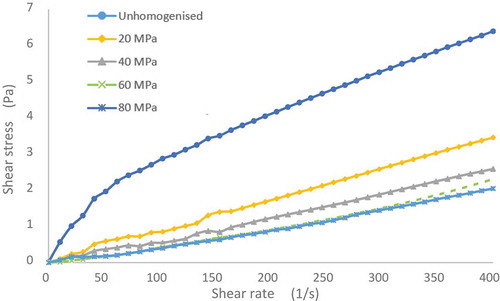
The Power Law consistency index k, flow behavior index m, and correlation coefficient R2 of the curves are shown in . It can be seen from this table, the regression coefficient is ranged from 0.9302 to 0.9956, which indicates that a satisfactory agreement with the experimental shear stress versus shear rate. The results show that the consistency coefficient k decreased with the increase of homogenization pressure. However, the flow behavior index m increased with the increase of homogenization pressure. It can be also concluded from the table that there is a remarkable increase in the m value (with high-pressure homogenization) compared to the untreated NRS paste. These results indicate that the high-pressure homogenization treatment increased the fluidity of starch paste and decreased the viscosity of the starch paste. These results are in accordance with that of Wang, Li, Wang, Liu, and Adhikari (Citation2012). When the homogeneous pressure reached 80MPa, the flow behavior index m rose up to near 1, which indicates that the NRS paste is close to Newtonian fluid and has good fluidity.
Table 1. Power law model parameters for normal rice starch (2%) treated by high-pressure homogenization.
Tabla 1. Parámetros del modelo de ley potencial para almidón de arroz normal (2%) tratado con homogeneización a alta presión.
3.1.2. Waxy rice starch (WRS)
) shows the rheological property of waxy rice starch paste (with and without high-pressure homogenization) as a function of shear rate. It can be seen from this figure, the shear stress of unhomogenized WRS paste is significantly greater than the homogenized WRS paste. However, there is a significant decrease in shear stress of the homogenized NRS compared to homogenized WRS. As can be seen from this figure, the shear stress of WRS increased with the increase of shear rate, but not increase linearly, which indicates the WRS (2% and 4%, w/v) belong to non-Newtonian fluids. It can be seen from ), the shear stress of 4% (w/v) waxy rice starch paste is much greater than that of 2% (w/v) waxy rice starch paste.
Figure 2. Effect of high-pressure homogenization on the rheology property of waxy rice starch: (a) 2%; (b) 4%.
Figura 2. Efecto de la homogeneización a alta presión sobre las propiedades reológicas del almidón de arroz ceroso: (a) 2%; (b) 4%.
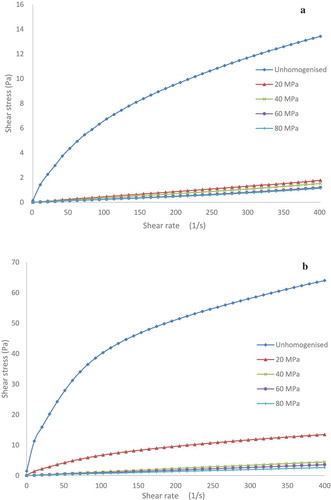
The Power Law equation (Equation (1)) was used to predict the shear rate dependence of shear stress. The k, m, and correlation coefficient R2 presented in and . It is clearly observed that the correlation coefficient is within 0.9396 ~ 0.9949, which indicates that the power law can fit the rheological characteristic curve of waxy rice starch (both 2% and 4%, w/v) treated by high-pressure homogenization. The consistency coefficient k decreased with the increase of homogenization pressure, while, the flow index m increased with the increase of homogeneous pressure, this is similar with the NRS. It can also be obtained from and , subjected to the same homogeneous pressure, 4% WRS has lower consistency coefficient and greater flow index compared to 2% WRS, which showed that the liquidity of 4% WRS is better.
Table 2. Power law model parameters for waxy rice starch (2%) treated by high-pressure homogenization.
Tabla 2. Parámetros del modelo de ley potencial para almidón de arroz ceroso (2%) tratado con homogeneización a alta presión.
Table 3. Power law model parameters for waxy rice starch (4%) treated by high-pressure homogenization.
Tabla 3. Parámetros del modelo de ley potencial para almidón de arroz ceroso (4%) tratado con homogeneización a alta presión.
3.2. Effect of high-pressure homogenization on apparent viscosity of rice starch
The shear rate dependence of apparent viscosity of normal rice starch pastes and waxy rice starch pastes (2%, w/v) is presented in ). As can be seen from , the apparent viscosity of starch paste (both normal rice starch and waxy rice starch) without high-pressure homogenization treatment decreased with the increase of shear rate, and then tended to be stabilized gradually, which indicate that the starch paste without high-pressure homogenization treatment is a shear thinning flow. This is ascribed to that the entangled molecular chains were straightened, and the shear stress between the laminar layers decreased, resulting in the decrease in the apparent viscosity of starch paste. When the shear rate increases to a certain value, the starch molecule is late or fully oriented, and the apparent viscosity of waxy rice starch is maintained at a constant.
Figure 3. The variation of apparent viscosity as a function of shear rate of (a) normal rice starch and (b) waxy rice starch.
Figura 3. Variación de la viscosidad aparente en función de la velocidad de corte de (a) almidón de arroz normal y (b) almidón de arroz ceroso.
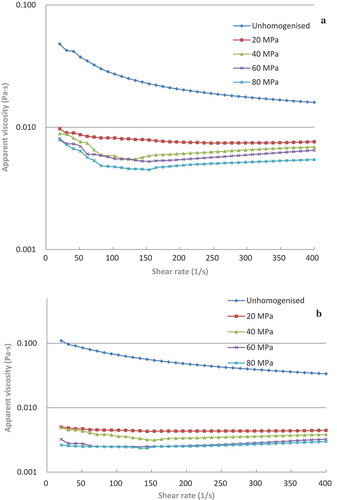
It can be seen from ), with the increase of shear rate, the apparent viscosity of starch paste (both NRS and WRS) with high-pressure homogenization treatment decrease sharply first, and then gradually tended to be flat. These results indicate that the rheological behaviors of starch paste appear shearing thinning. This is due to that the starch granules were disintegrated by the violent mechanical force involved in the high-pressure homogenization process (Fu et al., Citation2011). However, when the shear rate reached a certain value, the apparent viscosity of starch paste increased with the increase of the shear rate. This may be due to that an increase in the flow velocity which increases the kinetic energy of the particles. These results demonstrate that the 2% (w/v) starch paste (both normal rice starch and waxy rice starch) is a shear thickening fluid when the shear rate beyond a certain value. These results indicate that the kinetic energy of particle increased with the increase of flow rate, so that the kinetic energy crossed the energy barrier to reach the first minimum Em1 and the flocculation occurred, which increased the viscosity of particles.
From , we can also see that the waxy rice starch possessed higher apparent viscosity compared to normal rice starch, this is owing to that the macromolecules are entangled with each other, which causes great viscous resistance to the flow for waxy rice starch. However, the apparent viscosity of starch paste decreased with the increase of homogenization pressure. This is due to that during high-pressure homogenization process, the hydrogen bond between molecules was destroyed, and the structure became loose, and the entanglement point between molecules decreased, which lead to the decrease of the viscous resistance to flow.
3.3. Thixotropy of different pressure homogeneous rice starch paste
Shear loop was used to measure the thixotropy of starch paste. Firstly, the shear rate was increased from 0.1s-1 to 400 s-1, then decreased from 400 s-1 to 0.1s-1. The hysteresis loop means that the sample has thixotropy. The larger the area of the hysteresis circle, the more obvious the thixotropy of the sample.
It can be seen from , the thixotropy of 2% (w/v) starch paste without high-pressure homogenization treatment was the most noticeable, and the thixotropy of starch paste (both NRS and WRS paste) decreased with increasing homogenous pressure. When the homogenous pressure reached the 80 MPa, the thixotropy of NRS paste almost does not exist. These results suggest that the thixotropic behavior of the starch paste was weakened by high-pressure homogenization treatment (Wang et al., Citation2012).
Figure 4. Thixotropy of rice starch paste with different pressures: (a) NRS without high-pressure homogenization; (b) NRS with high-pressure homogenization; (c) WRS without high-pressure homogenization; (d) WRS with high-pressure homogenization.
Figura 4. Tixotropía de pasta de almidón de arroz con diferentes presiones: (a) NRS sin homogeneización a alta presión; (b) NRS con homogeneización a alta presión; (c) WRS sin homogeneización a alta presión; (d) WRS con homogeneización a alta presión.
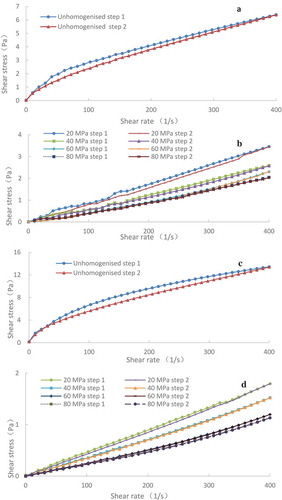
3.4. Frequency sweep of the rice starch paste
) shows the viscoelasticity of the waxy rice starch paste (with and without high-pressure homogenization) as a function of angular frequency. As can be seen from , the storage modulus (G’) is much greater than the loss modulus (Gʺ) in all samples, indicating that the WRS paste (with and without high-pressure homogenization) exhibits dominant elastic behavior than the viscous behavior. It can be observed from , the WRS paste with high-pressure homogenization had distinctly smaller storage modulus (G’) and loss modulus (G”) than the unhomogenized samples, both the G’ values and the G” values decreased with the homogeneous pressure, showing that the elastic behavior and viscous behavior are much weaker in homogenized WRS paste. These results suggest that high-pressure homogenization treatment is able to lower retrogradation of WRS paste during storage. This is due to the fragmentation of amylose and amylopectin caused by high-pressure homogenization. These results also show that high-pressure homogenization treatment is capable of increasing the fluidity of the WRS paste (Wang et al., Citation2012). This is ascribed to the fracture of hydrogen bond between starch molecules during the high-pressure homogenization process, which is consistent with Section 3.2.
4. Conclusion
Rice starch paste (both NRS and WRS) with and without high-pressure homogenization treatment is a non-newtonian fluid. The shear stress increased with the increasing shear rate for rice starch without high-pressure homogenization. Power law equation can fit the shear stress versus shear rate quite precisely. Shear thinning appeared before the onset of shear thickening with the increase of homogenous pressure. High-pressure homogenization treatment sharply decreased the thixotropy of starch paste, and the thixotropy of rice starch (both NRS and WRS) paste decreased with the increasing homogenous pressure. High-pressure homogenization treatment can effectively improve the rheological properties of rice starch paste, and it can help produce the modified starch that satisfies certain needs.
Conflict of interest
The authors declare no conflict of interest.
Additional information
Funding
References
- Bet, C. D., de Oliveira, C. S., Colman, T. A. D., Marinho, M. T., Lacerda, L. G., Ramos, A. P., & Schnitzler, E. (2018). Organic amaranth starch: A study of its technological properties after heat-moisture treatment. Food Chemistry, 264, 435–442. doi:10.1016/j.foodchem.2018.05.021
- Byars, J. (2002). Effect of a starch-lipid fat replacer on the rheology of soft-serve ice cream. Journal of Food Science, 67(6), 2177–2182. doi:10.1111/jfds.2002.67.issue-6
- Chang, L. T. (1998). The Greatly developing uses of starch. Journal of South China University of Technology, 26, 68–74.
- Che, L., Li, D., Wang, L., Özkan, N., Chen, X. D., & Mao, Z. (2008). Rheological properties of dilute aqueous solutions of cassava starch. Carbohydrate Polymers, 74(3), 385–389. doi:10.1016/j.carbpol.2008.03.007
- Colussi, R., Pinto, V. Z., El Halal, S. L. M., Vanier, N. L., Villanova, F. A., Marques, E., … Dias, A. R. G. (2014). Structural, morphological, and physicochemical properties of acetylated high-, medium-, and low-amylose rice starches. Carbohydrate Polymers, 103, 405–413. doi:10.1016/j.carbpol.2013.12.070
- Deng, R., & Xu, R. (2014). Compared of application of modified starch in oyster sauce. Food Science and Technology, 09, 263–266.
- Dong-soon, S., Zihua, A., Jay-lin, J., & Huang, J. (2005). Structure and application of starch. Guangxi Journal of Light Industry, 04, 27–29.
- Fu, Z., Wang, L., Li, D., Wei, Q., & Adhikari, B. (2011). Effects of high-pressure homogenization on the properties of starch-plasticizer dispersions and their films. Carbohydrate Polymers, 86(1), 202–207. doi:10.1016/j.carbpol.2011.04.032
- Guo, L. (2018). Sweet potato starch modified by branching enzyme, β-amylase and transglucosidase. Food Hydrocolloids, 83, 182–189. doi:10.1016/j.foodhyd.2018.05.005
- Homayouni, A., Azizi, A., Ehsani, M. R., Yarmand, M. S., & Razavi, S. H. (2008). Effect of microencapsulation and resistant starch on the probiotic survival and sensory properties of synbiotic ice cream. Food Chemistry, 111(1), 50–55. doi:10.1016/j.foodchem.2008.03.036
- Khurana, L. K., Singh, R., Singh, H., & Sharma, M. (2018). Systematic development and optimization of an in-situ gelling system for moxifloxacin ocular nanosuspension using high-pressure homogenization with an improved encapsulation efficiency. Current Pharmaceutical Design, 24(13), 1434–1445. doi:10.2174/1381612824666180403115106
- Kulicke, W., Eidam, D., Kath, F., Kix, M., & Kull, A. H. (1996). Hydrocolloids and rheology: Regulation of visco-elastic characteristics of waxy rice starch in mixtures with galactomannans. Starch - Starke, 48(3), 105–114. doi:10.1002/(ISSN)1521-379X
- Li, M., Tian, X., Jin, R., & Li, D. (2018). Preparation and characterization of nanocomposite films containing starch and cellulose nanofibers. Industrial Crops and Products, 123, 654–660. doi:10.1016/j.indcrop.2018.07.043
- Li, M., Wang, L., Li, D., Cheng, Y., & Adhikari, B. (2014). Preparation and characterization of cellulose nanofibers from de-pectinated sugar beet pulp. Carbohydrate Polymers, 102, 136–143. doi:10.1016/j.carbpol.2013.11.021
- Li, Y., & Lim, S. (2016). Preparation of aqueous alpha-lipoic acid dispersions with octenylsuccinylated high amylose starch. Carbohydrate Polymers, 140, 253–259. doi:10.1016/j.carbpol.2015.12.023
- Poonguzhali, R., Khaleel Basha, S., & Sugantha Kumari, V. (2018). Fabrication of asymmetric nanostarch reinforced Chitosan/PVP membrane and its evaluation as an antibacterial patch for in vivo wound healing application. International Journal of Biological Macromolecules, 114, 204–213. doi:10.1016/j.ijbiomac.2018.03.092
- Šárka, E., & Dvořáček, V. (2017). Waxy starch as a perspective raw material (a review). Food Hydrocolloids, 69, 402–409. doi:10.1016/j.foodhyd.2017.03.001
- Shi, A., Li, D., Wang, L., Zhou, Y., & Adhikari, B. (2012). Spray drying of starch submicron particles prepared by high pressure homogenization and mini-emulsion cross-linking. Journal of Food Engineering, 113(3), 399–407. doi:10.1016/j.jfoodeng.2012.06.017
- Turcanu, M., Siegert, N., Secouard, S., Brito-de La Fuente, E., Balan, C., & Gallegos, C. (2018). An alternative elongational method to study the effect of saliva on thickened fluids for dysphagia nutritional support. Journal of Food Engineering, 228, 79–83. doi:10.1016/j.jfoodeng.2018.02.015
- Vernon-Carter, E. J., Alvarez-Ramirez, J., Bello-Perez, L. A., Garcia-Hernandez, A., Roldan-Cruz, C., & Garcia-Diaz, S. (2018). In vitro digestibility of normal and waxy corn starch is modified by the addition of Tween 80. International Journal of Biological Macromolecules, 116, 715–720. doi:10.1016/j.ijbiomac.2018.05.076
- Wang, B., Li, D., Wang, L., Chiu, Y. L., Chen, X. D., & Mao, Z. (2008). Effect of high-pressure homogenization on the structure and thermal properties of maize starch. Journal of Food Engineering, 87(3), 436–444. doi:10.1016/j.jfoodeng.2007.12.027
- Wang, B., Li, D., Wang, L., Liu, Y., & Adhikari, B. (2012). Effect of high-pressure homogenization on microstructure and rheological properties of alkali-treated high-amylose maize starch. Journal of Food Engineering, 113(1), 61–68. doi:10.1016/j.jfoodeng.2012.05.021
- Wang, Q., Feng, Y., & Wen, Q. (2005). Applications of waxy maize starch and its modified starch in food industry. Cereal & Food Industry, 04, 23–25.
- Zhou, M., Gao, M., Kong, Q., & Zhu, P. (2018). High-performance starch/clay bionanocomposite for textile warp sizing. Polymer Composites, 39, E441–E447. doi:10.1002/pc.v39.S1

